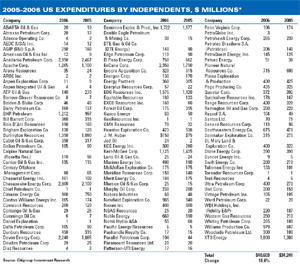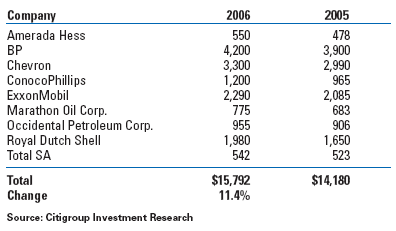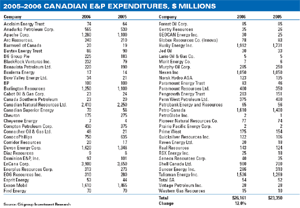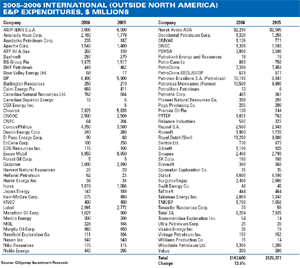OUTLOOK 2006: United States
E&P SPENDING
Worldwide oil industry spending to increase 14.1%
Spending to continue, even if oil prices moderate.
Geoff Kieburtz, Michael McNair, Megan Bissell, Citigroup, New York
Citigroup Investment Research (CIR), a division of Citigroup Global Markets Inc., published its 24th annual E&P Spending Survey on December 12, 2005. The 40-page report includes results from 196 oil and gas companies (up from 183 for 2004), and analyzes spending for 2005 and plans for 2006, focusing on the US, Canada and Outside North America. The data comprise 52 tables and figures, plus CIR’s comments, survey highlights, the survey process and results, and company observations.
The survey projects that global upstream expenditures will jump 14.1% in 2006 compared with 2005’s levels. Spending in the US is forecast to rise 16.5% versus last year’s figure, and Canadian spending is planned to increase 12%. Outside North America, planned expenditures should be 13.6% higher than in 2005. Initial worldwide spending plans for 2005 in last year’s survey represented 5.5% growth, but actual expenditures were up 19.1%. The US market posted the largest upward revisions to initial and mid-year forecasts for 2005 and generated the strongest demand growth. This is likely to repeat in 2006.
Most respondents last year expected service and drilling prices to increase in 2005, but fewer than one-third expected these to have a meaningful impact on investment plans. In this survey, virtually all respondents expect price increases, and most have incorporated price increases explicitly into spending plans. Price inflation estimates average about 15%. Most operators willing to discuss the topic expect to partially offset price increases with productivity gains and extension of existing contracts where possible. Expectations for price inflation are most notable Outside North America.
Spending plans appear robust, even if oil and gas prices decline significantly from current levels. In fact, average oil and natural gas assumptions underlying respondents’ spending plans have jumped again, to about $50/bbl and $8/Mcf, respectively. For the first time in the history of this survey, just sustaining current prices would prompt most respondents to spend 10% more than initial plans. Another trend observed over the last five years is that actual E&P expenditures by respondents have exceeded their initial plans by significant amounts.
Survey highlights. Initial worldwide spending plans for 2006 are set to rise to $226.2 billion in 2006, compared to $198.1 billion in 2005. Actual worldwide expenditures in 2005 were up 19.1%. The growth is balanced across all regions. We believe these expenditures, encompassing major, national, and independent companies operating on six continents, represent the most comprehensive survey of forecast 2006 investment. Of the planned spending, 63% is earmarked for international markets, 25% for the US, and 12% for Canada. The percentage of international spending is greater than 65%, as the majority of the spending not included in our survey comes from Middle Eastern nations where reliable data have not been available.
Within our survey, the 10 largest spenders account for 44% of total spending and the top 50 nearly 87%. Our data do not include acquisitions, so we have adjusted historical numbers to reflect acquisitions as if they had occurred at the beginning of the survey period.
Spending in the US is forecast to rise to $56.4 billion, and Canadian spending is planned to increase to $26.2 billion.
Expenditure growth will likely be limited by capacity. A record 80% of respondents expressed concern about rig availability, which some operators have combated by securing long-term contracts, accepting replacement pricing to encourage newbuilds, and purchasing their own rigs. In addition, 60% indicated a potential shortage of skilled personnel. Service and drilling industry conditions are the best in a generation. For the fourth straight year, the percentage of respondents deeming the economics of drilling to be more favorable than those of acquiring reserves increased. A total of 93% of respondents agreed with this supposition, up from 92% a year ago. Given the run-up in both oil and gas prices, acquisition prices have increased significantly, making growth through the drill bit more attractive.
US independents. In the US, 116 independents surveyed plan an 18.6% increase in 2006 upstream expenditures, to $40.6 billion. This compares with growth rates of 41.1% in 2005 and 24.6% in 2004. Spending plans appear to have upside potential, based on oil and natural gas being near or at historical highs. We note that initial spending plans in 2004 (+2.4%) and 2005 (+9.7%) were extremely conservative. With an upbeat economic environment and very strong balance sheets, the main constraint on spending for independents appears to be capacity, particularly access to rigs and personnel. Pricing sensitivity remains skewed to the upside, so we view the initial spending plans as conservative. This is particularly true in the case of natural gas, as the current futures strip of $12.38/Mcf is far above the $9.91/Mcf level indicated by independents as the price at which spending would increase by 10% over initial forecasts.
In the coming year, the largest spending increases are projected to come from Chesapeake Energy ($700 million), EnCana ($600 million) and XTO Energy ($500 million). Conversely, large declines are anticipated from Kerr-McGee ($310 million) and Forest Oil ($220 million). On a percentage basis, the largest increases, by far, emanate from the smallest independents.
 |
| |
2005-2006 US Expenditures By Independents
Click image for enlarged view |
|
|
|
US majors. The nine firms we designate as major oil companies plan to increase US spending by 11.4% in 2006, to $15.8 billion, following 11.0% growth in 2005. This represents a significant improvement compared with 2003 and 2004, when, as a group, the majors’ US spending growth was – 1.0% and 2.6%, well below worldwide E&P spending growth of 9.4% and 10.3%.
We attribute this more favorable view toward US exploration and production to robust commodity prices, which have stalled the majors’ asset divestiture programs. Prior to this year, major operators had been active sellers of mature properties, as they shifted their focus toward more prospective deepwater and international opportunities. Now, properties once deemed marginal at lower commodity prices are solidly profitable, especially given the well-developed production infrastructure that exists in the US that allows the majors to quickly bring refined products to market. In addition, advancements in drilling technology are opening up new areas with significantly greater potential, such as the deep gas play in the shallow waters of the Gulf of Mexico.
| 2005–2006 US EXPENDITURES BY MAJOR OIL & GAS COMPANIES, $ MILLIONS |
 |
|
Aggregate US spending is forecast to increase 16.5% in 2006, to $56.4 billion, compared with a 30.9% rise in 2005. Of the 125 respondents, 83% expect higher spending, 9% expect lower spending, and 8% expect no change, for a total increase of $8.0 billion. The growth is broad-based, with 25 companies expecting to spend at least $100 million more.
Canada. Sixty-four companies plan a 12.0% spending increase in 2006, to $26.2 billion, following growth rates of 23.6% in 2005 and 8.9% in 2004. In 2005, the Canadian rig count surged by more than 22% to a record level, in line with spending growth.
Despite the fact that 58% of respondents view the availability of attractive drilling prospects as an impediment to growth, a healthy spending increase is planned in 2006. This anticipated increase comes despite the increasing popularity of conversions to income trusts.
As in 2005, pricing should play a key role, with 46% of Canadian respondents indicating that expected service and drilling prices have a significant impact on E&P spending plans, up from 31% that felt that way a year ago.
Merger and acquisition activity slowed significantly in 2005, resulting in a market dominated by several large independents, such as EnCana and Husky Energy. Thus, we expect spending plans to be more inelastic than in prior years, although not to the extent of those of the much larger integrated majors.
For 2006, the largest incremental spending increases are anticipated from Devon Energy, Talisman Energy, EnCana, and Petro-Canada, with only Chevron forecasting a material decline.
 |
| |
2005-2006 Canadian E&P Expenditures
Click image for enlarged view |
|
|
|
International. Outside North America, the 84 companies surveyed plan a 2006 spending increase of 13.6%, to $143.6 billion, from $126.4 billion, compared to increases of 14.4% in 2005 and 8.7% in 2004.
Roughly 30% of the 2006 spending increase is from Latin American oil companies, most notably Petrobras, where E&P spending is anticipated to rise by more than $4 billion, year over year. The significant increase is due to development costs, as the company will be investing heavily in several production platforms.
Other companies anticipating significant international spending increases are Royal Dutch/ Shell, Chevron, Exxon Mobil, and ConocoPhillips. The largest declines are projected from Sinopec, Norsk Hydro and Surgutneftegaz.
 |
| |
2005-2006 International (Outside North America) E&P Expenditures
Click image for enlarged view |
|
|
|
Key observations. The following additional points of interest emerged from the survey:
- In contrast to last year’s survey, operators overall are not showing a preference for either oil or natural gas, as 65% of respondents expect no shift in activity. In the 2004 survey, only 51% felt this way.
- The percentage of respondents that overspent cashflow rose to 33% in 2005 from 27% in 2004, but this percentage is expected to decline to 25% next year. In fact, in 2006, 61% of respondents are expecting to underspend cashflow, the highest such percentage in at least 10 years. Consequently, the percentage of respondents citing operating cashflow as a key determinant of their spending plans in 2005 and 2006 fell to 39% and 37%, respectively, all-time lows.
- The trend toward more exploration (versus development) that commenced in 2003 appears to be waning, with the exception of Canada. Globally, 35% of respondents are shifting their focus toward exploration, down from 42% that expected to do so in last year’s survey.
- A smaller percentage of respondents overall are planning to increase spending on lease expenditures. A total of 43% of respondents indicated a shift toward higher lease expenditures, down from 50% a year ago. This bodes well for the prospect of higher development spending, particularly in the US and Canada.
- In the US, respondents rated the economics of exploration at their highest level in at least a decade, with 70% viewing the situation as good to excellent, up slightly from 68% a year ago. Outside North America, economics for both oil and gas were rated slightly less favorable than a year ago, 83% versus 87%, but the overall view remains clearly positive.
- Although down from a year ago, a large percentage of respondents still expect to spend more on seismic next year. A total of 50% of respondents plans to increase spending on seismic in 2006, versus only 7% expecting to decrease. This 7:1 ratio surpasses the 6:1 ratio seen in last year’s survey, which at the time was the strongest positive response since 1997.
- Respondents indicated a marked focus shift away from offshore drilling. Worldwide, only 12% expect to shift their focus toward offshore versus 32% that expected to do so a year ago. This may be because, although reservoirs on land tend to be smaller than offshore, they are generally less costly to develop and can be brought online more quickly.
- Extending the trend from the early 1990s, seismic technology continues to be viewed as the technology or trend with the highest impact on E&P spending plans, with 67% distinguishing it from other technologies, up from 61% a year ago. What is notable is the significant increase in horizontal/ directional drilling, with 59% of respondents listing it this year, up from 43% a year ago.

Note: Citigroup Investment Research cautions that it is not statistically accurate to compare total estimates with those from prior years because the companies surveyed vary from year to year.
|






